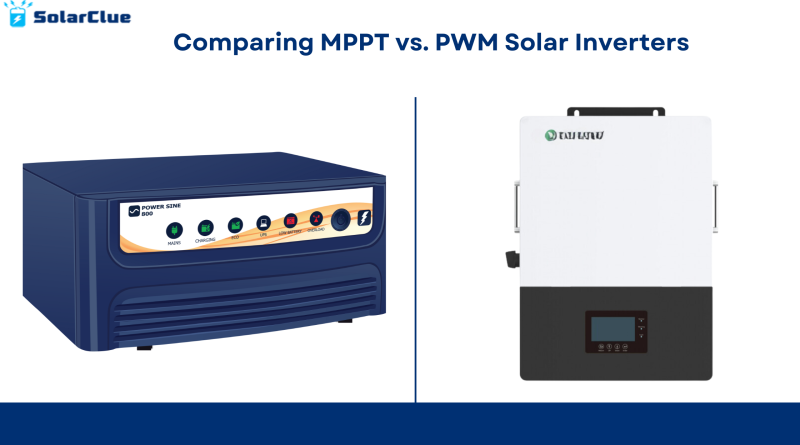Comparing MPPT vs. PWM Solar Inverters: Which Is Right for You?
If you’re considering making the switch to solar power for your home or business, One of the key decisions you’ll face when setting up your solar energy system is choosing the right type of solar inverter. In this blog post, we’re going to talk about the differences between MPPT (Maximum Power Point Tracking) and PWM (Pulse Width Modulation) solar inverters. Don’t worry if these terms sound a bit technical right now—we’ll break it down into simple, understandable terms so you can make an informed choice for your home or business.
Table of Contents
- 1 Understanding Solar Inverters :
- 1.1 PWM Solar Inverters :
- 1.2 How it Works :
- 1.2.1 MPPT Solar Inverters :
- 1.2.2 How it works:
- 1.2.3 MPPT inverters continuously monitor the voltage and current output of your solar panels and make adjustments to match the optimal operating point for maximum energy production. This means that even in suboptimal conditions, such as partial shading or temperature fluctuations, MPPT inverters can still extract the maximum possible power from your solar panels.
Understanding Solar Inverters :
Solar inverters are the essential link between your solar panels and the electrical devices in your home or business. Their primary job is to convert the direct current (DC) electricity generated by your solar panels into alternating current (AC) electricity, which is the type of electricity used by most household appliances and electronics.
Without an inverter, all that clean, renewable energy generated by your solar panels would go to waste! Inverters ensure that the electricity produced by your solar system is compatible with your electrical needs, allowing you to harness the power of the sun efficiently.
PWM Solar Inverters :
PWM stands for Pulse Width Modulation, which is a straightforward technology used in some types of solar inverters. These inverters regulate the amount of energy going into your batteries by rapidly switching the solar panels on and off. It’s kind of like using a light switch to control the flow of electricity—it’s either on or off.
How it Works :
PWM inverters work by rapidly switching the flow of electricity on and off, essentially chopping up the DC electricity from your solar panels into small pulses. These pulses are then converted into AC electricity that can be used by your household devices.
One of the key advantages of PWM inverters is their affordability. They tend to be less expensive than their MPPT counterparts, making them an attractive option for those on a tighter budget. Additionally, PWM inverters are relatively simple in design, which can make them easier to install and maintain.
However, PWM inverters do have some drawbacks. They are generally less efficient than MPPT inverters, particularly in situations where the solar panels are operating at less-than-optimal conditions, such as in partial shade or when the temperature fluctuates. This reduced efficiency can lead to lower energy production and, ultimately, higher electricity bills.
PWM inverters are generally simpler and less expensive than MPPT inverters. They work well in smaller solar installations where efficiency isn’t as critical, such as in small cabins or basic off-grid setups. If your primary goal is to keep costs down and you have a straightforward solar setup, a PWM inverter could be a good fit for you.
MPPT Solar Inverters :
let’s shift our focus to MPPT solar inverters. which stands for Maximum Power Point Tracking. Unlike PWM inverters, MPPT technology is more advanced and efficient. MPPT inverters constantly adjust the voltage and current to extract the maximum power available from your solar panels at any given time. Think of it as having a smart system that optimizes solar panel output to get the most energy possible, even when conditions like sunlight intensity or panel temperature change.
How it works:
MPPT inverters continuously monitor the voltage and current output of your solar panels and make adjustments to match the optimal operating point for maximum energy production. This means that even in suboptimal conditions, such as partial shading or temperature fluctuations, MPPT inverters can still extract the maximum possible power from your solar panels.
The increased efficiency of MPPT inverters can translate into significant energy savings over time, especially in larger solar setups. However, this added efficiency comes at a higher upfront cost, as MPPT inverters tend to be more expensive than their PWM counterparts.
MPPT inverters are ideal for larger solar systems or installations where maximizing efficiency and output is crucial. They are more expensive than PWM inverters but can significantly increase the overall performance and energy yield of your solar setup. If you’re looking to get the most out of your solar investment and have a larger array of panels, an MPPT inverter is likely the better choice.
Choosing the Right Inverter for You
When it comes down to choosing between MPPT and PWM inverters, consider the size and complexity of your solar installation, your budget, and your energy goals. Here are a few key points to keep in mind.
Now that you understand the differences between PWM and MPPT solar inverters, the burning question remains: which one is right for your solar setup? The answer, as with many things in life, depends on your specific needs and circumstances.
If you’re working with a smaller solar system, such as a few panels for your home, and you’re on a tight budget, a PWM inverter might be the way to go. While it may not be as efficient as an MPPT inverter, the lower upfront cost can make PWM inverters an attractive option for those just dipping their toes into the world of solar energy.
On the other hand, if you’re planning a larger solar installation, such as for a commercial building or a sizable residential system, an MPPT inverter is likely the better choice. The increased efficiency of MPPT inverters can lead to significant energy savings over time, potentially offsetting the higher initial cost and making it a more cost-effective option in the long run.
Additionally, if your solar panels are likely to experience frequent shading or temperature fluctuations, an MPPT inverter may be the better choice. Its ability to adapt to varying conditions and extract maximum power from your solar panels can help maximize your energy production, even in less-than-ideal situations.
Conclusion :
Well, there you have it, a deep dive into the world of solar inverters and the battle between MPPT and PWM technology. While both inverter types have their merits, the decision ultimately comes down to your specific needs, budget, and the size of your solar setup.
Remember, whichever inverter you choose, you’re taking a step towards a more sustainable future and reducing your carbon footprint. So, whether you go with the affordable simplicity of a PWM inverter or the cutting-edge efficiency of an MPPT inverter, you can rest assured that you’re doing your part in harnessing the power of the sun.
We hope this blog post has helped clarify the differences between MPPT and PWM inverters and has empowered you to make an informed decision for your solar journey.
Visit SolarClue® to see the best Solar Inverters. SolarClue® actively sells solar energy products at discounts of up to 50%.
Frequently Asked question:
1.Why is MPPT better than PWM?
The MPPT controller is able to capture the excess module voltage to charge the batteries.
2.What is the disadvantage of MPPT?
The main drawback of MPPT charge controllers is that they are more expensive and complex than PWM charge controllers.
3.What is the disadvantage of PWM?
It increases the switching frequency and stress of the power device, reducing its lifetime and increasing its switching losses and EMI emissions.
4.Why is PWM preferred?
it allows for controlling the average amount of power delivered to a load or the output.



